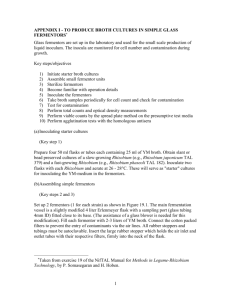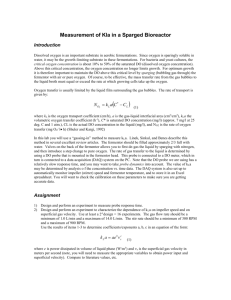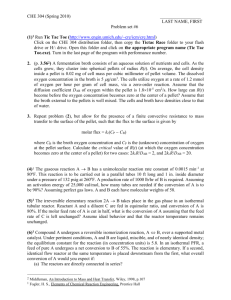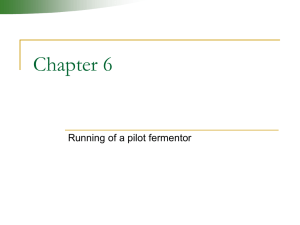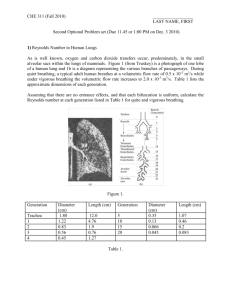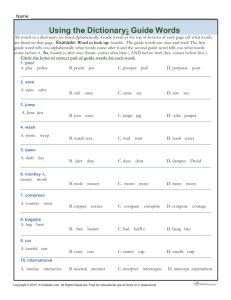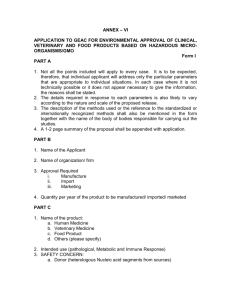Rhizobia Culture in Glass Fermentors
advertisement
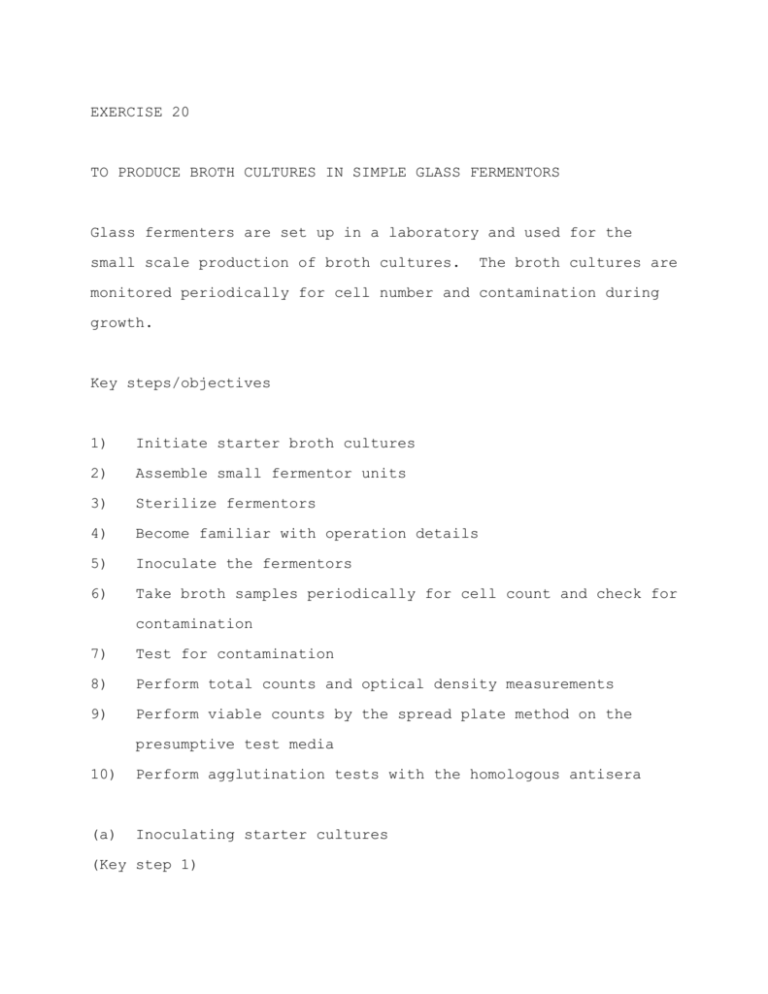
EXERCISE 20 TO PRODUCE BROTH CULTURES IN SIMPLE GLASS FERMENTORS Glass fermenters are set up in a laboratory and used for the small scale production of broth cultures. The broth cultures are monitored periodically for cell number and contamination during growth. Key steps/objectives 1) Initiate starter broth cultures 2) Assemble small fermentor units 3) Sterilize fermentors 4) Become familiar with operation details 5) Inoculate the fermentors 6) Take broth samples periodically for cell count and check for contamination 7) Test for contamination 8) Perform total counts and optical density measurements 9) Perform viable counts by the spread plate method on the presumptive test media 10) Perform agglutination tests with the homologous antisera (a) Inoculating starter cultures (Key step 1) Prepare four 50 ml flasks or tubes each containing 25 ml of YMB. Obtain slant, or lyophilized bead preserved cultures of bradyrhizobia (e.g., B. japonicum TAL 102) and fast growing rhizobia (e.g., Rhizobium sp. TAL 1145 from Leucaena leucocephala). Inoculate two flasks with each rhizobial strain and aerate at 25-30C. These will serve as "starter" cultures for inoculating the YMB in the fermentors. (b) Assembling simple fermentors (Key steps 2 and 3) Set up two fermentors (one for each strain) as shown in Figure 20.1. The main fermentation vessel is a slightly modified 4 l Erlenmeyer flask with a sampling port (glass tubing 4 mm ID) fitted close to its base. YMB. Fill each fermentor with 2-3 l of Connect the cotton packed filters to prevent the entry of contaminants via the air lines. must be autoclavable. All rubber stoppers and tubings Insert the large rubber stopper which holds the air inlet and outlet tubes with their respective filters, firmly into the neck of the flask. Connect the air inlet tube to an aquarium pump. Activate the pump and check the air inlet and outlet filters for air resistance. Air should flow freely through both filters while bubbling through the broth and simultaneously aerating and agitating the medium. uniformly but loosely. The cotton in the filters should be packed Overpacking the air inlet filter can cause resistance to incoming air and lead to poor aeration. Overpacking of the outlet filter can lead to poor air escape and pressure build-up in the fermentor. Disconnect the fermentor from the pump and prepare it for autoclaving. Make sure that the stopper which holds the air tubes is still firmly seated. The air supply system must be well protected to prevent entry of contaminants. Wrap the top of each flask with a wide band of non-absorbent cotton and secure it with a string. Then, add a protective wrapper of aluminum foil (Figure 20.2). Close the air inlet tube with a clamp at the spot indicated in Figure 20.1 to prevent the broth from leaving the flask due to pressure build up in the flask during autoclaving. Pressure relief during autoclaving occurs through the air outlet tube which must be left open. The filters should remain connected to the fermentor during autoclaving. To provide a convenient place for them, make an oversized wire ring to fit snugly around the neck of the fermentor vessel and twist it to obtain an eyelet or loop on each side. Each filter may then also be fitted with a piece of wire ending in a small hook. filters onto the eyelet (Figure 20.2). Hook the Sterilize the assembly for 40 min, if it contains approximately 2 l of broth. Adjust the sterilization time according to the volume of liquid; increase time by 10 min for each additional liter. After the fermentor has cooled, remove the clamp from the air inlet tubing. Connect the air supply to check for proper Figure 20.1. Scheme of simple fermentor unit a - Aluminum foil; b - Non absorbent cotton; c - Autoclavable stopper; d - Filter unit; e - Glass tubing; f - Wire ring; g - Growth medium; h Flask; i - Sampling tube; j - Plug; k - Latex tubing; l - Hose clamp; m - Aquarium pump; n - Wire hook Figure 20.2. Simple fermentor in operation. aeration once again and for leaks in the system. Various types of air systems have been used to aerate small fermentors including compressors, compressed air in tanks, aspirators, and aquarium pumps. The latter have been very satisfactory for small units and are inexpensive, silent, and dependable. Figure 20.3 Modified fermenter. Although a pressure relief valve may be desirable, it is not really necessary. Most aquarium pumps generate only low pressure, sufficient however, for several (four) fermentor units which may be connected to one aquarium pump using a manifold. (c) Operating the glass fermentors (Key step 4) General operation: If, after autoclaving, the fermentor has been inspected and found to function properly, it is ready for inoculation with the starter culture. If an aquarium pump is used, and more than one fermentor is attached, adjust the air to achieve an equal flow to each fermentor. For other air supply systems, adjust the air flow on the bypass which may be installed between the pump and the air inlet filter. The glass fermentor is inoculated through the latex air inlet, just above the main stopper tubing, with a sterilized syringe fitted with an 18 G needle. Care must be taken that no contaminants are introduced. Twenty ml of the starter culture are removed aseptically from its flask. The air inlet tubing is swabbed with 70% alcohol (or 3% hydrogen peroxide) about one inch above its connection to the glass tube. The needle is inserted downwards into the tubing and the culture is injected. The airstream will facilitate speedy entry and incorporation of the starter inoculum into the YMB. The culture is incubated at 25-30C under continuous aeration. Sampling procedures: Aseptically, with a sterile syringe, withdraw culture broth from the fermentor through the sampling tubing attached to the sampling port. alcohol or 3% hydrogen peroxide. Swab the tubing with 70% Insert the needle into the sterilized portion of the tubing and withdraw the desired amount of culture broth. For quality control purposes (such as Gram stain, pH measurements, optical density measurements, the total count, and plate counts), 5-10 ml of culture are sufficient and may be withdrawn by using a 5 or 10 ml syringe fitted with a 22 gauge needle. For injection of the broth culture into bags of sterile carrier (peat), 40 ml samples are usually withdrawn with a sterile 50 ml syringe fitted with a 18 gauge needle. Alternatively, an automatic motorized syringe equipped with a 16 gauge needle may also be used to withdraw broth culture if large numbers of bags are to be injected. In a modified system, a 1 l collection flask is connected to the fermentor as shown in Figure 20.3. This collection flask should be autoclaved together with the fermentor. It is connected to the fermentor via a tubing attached to a sampling tube running through the stopper on top of the unit and into the broth culture. A sampling port at the bottom of the fermentor is not needed in this case. The broth culture is forced into the sampling flask by temporarily closing off the air outlet of the fermentor while the pump is running. (d) Producing broth inoculum (Key steps 5, 6, 7, 8, 9, and 10) When the starter cultures have reached the end of their log phase of growth (7 days for a slow-growing rhizobia and 5 days for a fast-growing rhizobia, respectively), they are ready to be used for inoculating the fermentor. Inoculate one fermentor with B. japonicum TAL 102 and the other with the fast-growing Rhizobium sp. TAL 1145. Take a 10 ml sample from each fermentor at the end of the growth period of each strain and conduct the following tests: 1) pH tests: A contamination problem is usually evident when the pH of the broth decreases toward acidity especially with slow-growing, alkali-producing rhizobia (e.g., B. japonicum). However, with fast-growing, acid producing rhizobia (e.g., Rhizobium sp. from L. leucocephala) the pH test is less helpful since most contaminants are usually acid producers. Test the broth pH of the slow-growing rhizobia by adding two drops of bromthymol blue (0.5% w/v in alcohol) in 1 ml broth. With most strains tested, the pH does not change during mass culturing. A yellow coloration indicates acidity (presence of contaminants) and a green to blue coloration alkalinity (absence of contaminants). 2) Gram stain (Exercise 3) 3) Peptone glucose test (Exercise 3) 4) Total count with Helber or Petroff-Hausser counter (Exercise 4) 5) Optical density measurement (Exercise 4) 6) Spread plate count on YMA containing Congo Red and on YMA containing BTB (Exercise 4) 7) Agglutination with the homologous antiserum: This should be done just before harvesting when the culture has no less than 1 x 109 cells per ml. Dilute 2 ml of the cell suspension with 2 ml saline. Mix well and heat in boiling water for 30 min. After cooling, pipette 0.5 ml into an agglutination tube and add 0.5 ml of a 1:50 dilution of the homologous antiserum which should have a titer of at least 800. Perform the agglutination test as described in Exercise 7. The broth cultures may be incorporated into carrier material when the total count indicates a cell concentration of more than 1 x 109 cells per ml and purity of culture has been established. Requirements (a) Inoculating starter cultures Transfer chamber Platform shaker Inoculation loop, flame Erlenmeyer flasks or screw capped tubes of 50 ml capacity containing 25 ml YMB each (b) Assembling simple fermentors Large autoclave, aquarium pumps or compressor Cork borer, small glass file, bunsen burner For each fermentor: Erlenmeyer flask, 4 l, (This flask is modified by the addition of an outflow tube (ID 4 mm) at its base. These modified flasks are not available commercially, but any glass blower should be able to attach the short 3-5 ml glass tube.) #12 autoclavable stopper Glass tubing, inside diameter (ID 4 mm), approximately 120 cm Glass tubing, (ID 30 mm), two pieces of 10 cm length for making air filters. Barrels of 50 ml syringes may be cut to size and used instead. Rubber stoppers #4, autoclavable, four pieces Hose clamps, two, air by-pass (T-piece with short latex tube and clamp) Surgical rubber tubing (ID 4 mm), approximately 150 cm Glasswool, cotton wool, non-absorbent, aluminum foil Sampling tubes (ID 4 mm) YMB (2-3 l per fermentor) (c) Operating the glass fermentors Syringes (30 ml), sterile with 18G needles 70% alcohol, cotton swabs or tissue paper Broth culture of B. japonicum TAL 102 Broth culture of Rhizobium sp. TAL 1145 Syringes, sterile (10 ml); 22G needles Test tubes, sterile (for samples) (d) Producing broth inoculum Spectrophotometer; cuvettes, transfer chamber Antisera of TAL 102 and TAL 1145 Plates of peptone glucose agar Plates of YMA containing BTB Plates of YMA containing Congo Red Syringes (20-30 ml); 22G needles Test tubes, sterile (for samples) Pipettes, sterile (1 ml); pipettes, sterile (10 ml) Tubes containing 9 ml sterile diluent, rack Pasteur pipettes, sterile, calibrated Solution of Bromthymol Blue (0.5% w/v in ethanol) Materials and supplies for Gram stain (Appendix 3)
